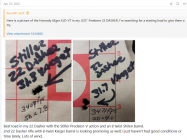Everybody is forgetting the most fundamental concept to accuracy.
It is not about the powder, primer or case, or even bullet jump into the lands(sort of, explained later).
What it is about, is having a perfectly balanced bullet and the point where the bullet leaves the end of the barrel, where the position of the barrel is at its ZERO point in the harmonic resonance cycle of the barrel.
(Note: heavier barrels are easier to get accuracy from as their harmonics are greatly reduced, less flex, because of the thickness of the steel).
So what affects the harmonics of a barrel as the bullet is traveling down the barrel:
- barrel thickness
- barrel length
- pressure curve in the barrel as the bullet travels through it, which leads to the final velocity of the bullet exiting the barrel.
What influences the pressure curve behind the bullet going through the barrel:
- powder charge
- primer(somewhat)
- case volume(somewhate)
- bore tightness
- how many lands
- how smooth the bore is
- barrel length
- bullet jump(affects the pressure curve)
Now about bullet jump, it affects the pressure curve and final velocity of the bullet exiting the barrel, which the velocity in turn, is also affecting the point in the harmonic cycle of the barrel.
(Note: do you really believe that wether you are jumping .010 or .030 or jamming the bullet into the lands, has any affect on the bullet accuracy as it is being squished and rotated down the length of the stove pipe... NO...
All that is being affected is the final bullet velocity and the harmonic point the barrel is at when the bullet exits).
Now about twist rate. You need to have the bullet traveling in flight, to be very balanced as it rotates. This begins with a high quality balanced bullet and a twist rate that will keep it spinning without falling out of balance in flight. The bullet mfg will let you know twist rate and velocity required for a peticular bullet.
Another super important factor in achieving accuracy, is using a bullet that touches into the lands before the base of the bullet has come out of the case neck. Otherwise the bullet has free-float before touching lands and it can be driven into the lands off the center of its eccentricity, then it is squished and rotated, exiting the barrel in a wobble state to start off with. NO accuracy. So when using boat-tail bullets, this holds true that the shoulder base, where the boat-tail begins, must be in the case still as the bullet is going into the lands.
So what does this all mean. Use your favorite powder, favorite primer, favorite case(all these don't really mater), set for a forgiving bullet jump, because what you are looking for is the velocity(using your favorite components above and powder charge) that gives you that cloverleaf bullet hole group at 100yds. Then you have found the point in the harmonic cycle of the barrel where it is at the ZERO point. This is the velocity for your barrel with that bullet weight. So now if you change any componet (keeping bullet weight the same), you just need to load to the same velocity and your accuracy will be there. Now if you change bullet weight, you need to find the new velocity where your barrel is at the ZERO point in the harmonic cycle. This will be the new velocity for that bullet weight.
(Note of interest: I know 223rem shooters that use 40gr bullets at 3700fps, jumping .200" to the lands, that shoot ragged one-hole groups, so the people that think you need those tight jumps to the lands, not true).
I hope this helps all who are loading to find that great accuracy point; the VELOCITY where the barrel is at its ZERO point in its harmonic cycle as the bullet exits the barrel. This is usually the point where you get those ragged one-hole, cloverleaf groups.
Cheers...













